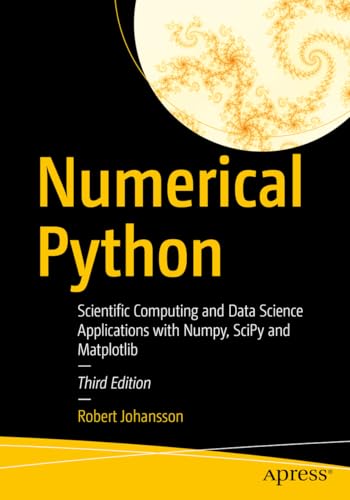Numerical Python: Scientific Computing and Data Science Applications with Numpy, SciPy and Matplotlib - Softcover

Inhaltsangabe
Learn how to leverage the scientific computing and data analysis capabilities of Python, its standard library, and popular open-source numerical Python packages like NumPy, SymPy, SciPy, matplotlib, and more. This book demonstrates how to work with mathematical modeling and solve problems with numerical, symbolic, and visualization techniques. It explores applications in science, engineering, data analytics, and more.
Numerical Python, Third Edition, presents many case study examples of applications in fundamental scientific computing disciplines, as well as in data science and statistics. This fully revised edition, updated for each library's latest version, demonstrates Python's power for rapid development and exploratory computing due to its simple and high-level syntax and many powerful libraries and tools for computation and data analysis.
After reading this book, readers will be familiar with many computing techniques, including array-based and symbolic computing, visualization and numerical file I/O, equation solving, optimization, interpolation and integration, and domain-specific computational problems, such as differential equation solving, data analysis, statistical modeling, and machine learning.
What You'll Learn
- Work with vectors and matrices using NumPy
- Review Symbolic computing with SymPy
- Plot and visualize data with Matplotlib
- Perform data analysis tasks with Pandas and SciPy
- Understand statistical modeling and machine learning with statsmodels and scikit-learn
- Optimize Python code using Numba and Cython
Who This Book Is For
Developers who want to understand how to use Python and its ecosystem of libraries for scientific computing and data analysis.
Die Inhaltsangabe kann sich auf eine andere Ausgabe dieses Titels beziehen.
Über die Autorin bzw. den Autor
Robert Johansson is an experienced Python programmer and computational scientist with a Ph.D. in Theoretical Physics from Chalmers University of Technology, Sweden. He has worked with scientific computing in academia and industry for over 15 years and participated in open source and proprietary research and development projects. His open-source contributions include work on QuTiP, a popular Python framework for simulating the dynamics of quantum systems, and he has also contributed to several other popular Python libraries in the scientific computing landscape. Robert is passionate about scientific computing and software development, teaching and communicating best practices for combining these fields with optimal outcomes: novel, reproducible, extensible, and impactful computational results.
Von der hinteren Coverseite
Learn how to leverage the scientific computing and data analysis capabilities of Python, its standard library, and popular open-source numerical Python packages like NumPy, SymPy, SciPy, matplotlib, and more. This book demonstrates how to work with mathematical modeling and solve problems with numerical, symbolic, and visualization techniques. It explores applications in science, engineering, data analytics, and more.
Numerical Python, Third Edition, presents many case study examples of applications in fundamental scientific computing disciplines, as well as in data science and statistics. This fully revised edition, updated for each library's latest version, demonstrates Python's power for rapid development and exploratory computing due to its simple and high-level syntax and many powerful libraries and tools for computation and data analysis.
After reading this book, readers will be familiar with many computing techniques, including array-based and symbolic computing, visualization and numerical file I/O, equation solving, optimization, interpolation and integration, and domain-specific computational problems, such as differential equation solving, data analysis, statistical modeling, and machine learning.
What You'll Learn
- Work with vectors and matrices using NumPy
- Review Symbolic computing with SymPy
- Plot and visualize data with Matplotlib
- Perform data analysis tasks with Pandas and SciPy
- Understand statistical modeling and machine learning with statsmodels and scikit-learn
- Optimize Python code using Numba and Cython
„Über diesen Titel“ kann sich auf eine andere Ausgabe dieses Titels beziehen.
Suchergebnisse für Numerical Python: Scientific Computing and Data Science...
Numerical Python
Anbieter: buchversandmimpf2000, Emtmannsberg, BAYE, Deutschland
Taschenbuch. Zustand: Neu. Neuware -Learn how to leverage the scientific computing and data analysis capabilities of Python, its standard library, and popular open-source numerical Python packages like NumPy, SymPy, SciPy, matplotlib, and more. This book demonstrates how to work with mathematical modeling and solve problems with numerical, symbolic, and visualization techniques. It explores applications in science, engineering, data analytics, and more.Numerical Python, Third Edition, presents many case study examples of applications in fundamental scientific computing disciplines, as well as in data science and statistics. This fully revised edition, updated for each library's latest version, demonstrates Python's power for rapid development and exploratory computing due to its simple and high-level syntax and many powerful libraries and tools for computation and data analysis.After reading this book, readers will be familiar with many computing techniques, including array-based and symbolic computing, visualization and numerical file I/O, equation solving, optimization, interpolation and integration, and domain-specific computational problems, such as differential equation solving, data analysis, statistical modeling, and machine learning.What You'll LearnWork with vectors and matrices using NumPyReview Symbolic computing with SymPyPlot and visualize data with MatplotlibPerform data analysis tasks with Pandas and SciPyUnderstand statistical modeling and machine learning with statsmodels and scikit-learnOptimize Python code using Numba and CythonWho This Book Is ForDevelopers who want to understand how to use Python and its ecosystem of libraries for scientific computing and data analysis.APress in Springer Science + Business Media, Heidelberger Platz 3, 14197 Berlin 512 pp. Englisch. Artikel-Nr. 9798868804120
Neu kaufen
Versand von Deutschland nach USA
Anzahl: 2 verfügbar
Numerical Python | Scientific Computing and Data Science Applications with Numpy, SciPy and Matplotlib
Anbieter: preigu, Osnabrück, Deutschland
Taschenbuch. Zustand: Neu. Numerical Python | Scientific Computing and Data Science Applications with Numpy, SciPy and Matplotlib | Robert Johansson | Taschenbuch | xx | Englisch | 2024 | Apress | EAN 9798868804120 | Verantwortliche Person für die EU: APress in Springer Science + Business Media, Heidelberger Platz 3, 14197 Berlin, juergen[dot]hartmann[at]springer[dot]com | Anbieter: preigu. Artikel-Nr. 129028760
Neu kaufen
Versand von Deutschland nach USA
Anzahl: 5 verfügbar
